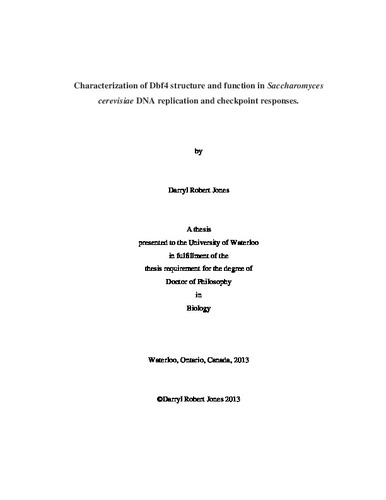| dc.description.abstract | The Dbf4/Cdc7 kinase complex is required for the initiation of DNA replication and promotes this by acting upon members of the Mcm2-7 helicase. In addition to its role in replication, Dbf4/Cdc7 is a target of the S-phase checkpoint response through the Rad53 checkpoint kinase. In the budding yeast Saccharomyces cerevisiae, the regulatory subunit of this complex, Dbf4, is essential for kinase activity. Dbf4 is conserved throughout eukaryotes and contains three regions of discrete homology, termed the N, M, and C motifs, based on their location in the polypeptide chain.
Motif C shows the highest conservation of all the motifs of Dbf4 and contains a CCHH type zinc finger. Mutation of the conserved cysteine and histidine residues of this zinc finger impair interactions with origin DNA and the Mcm2-7 helicase subunit Mcm2, but do not disrupt associations with Cdc7, Orc2, or Rad53. Cells where the endogenous Dbf4 CCHH zinc finger has been mutated exhibit slowed growth, and are delayed in their entry to, and progression through S-phase. These cells also display sensitivity upon long-term exposure to the ribonucleotide reductase inhibitor hydroxyurea (HU) and the DNA alkylating agent methyl methanesulfonate (MMS).
The crystal structure of an amino-terminal region of Dbf4 containing motif N folds as a BRCA1-carboxy-terminal (BRCT) domain. This domain is required for the interaction with Rad53, but is not sufficient. A fragment of Dbf4 containing the BRCT domain and its fifteen preceding amino acids is sufficient to interact with Rad53 and folds as a modified BRCT domain containing an integral amino-terminal helical projection. Denoted the Helix-BRCT (HBRCT) domain, mutations that destabilize it abrogate the interaction with Rad53, and result in sensitivity to genotoxic agents.
Dbf4 is recognized by the forkhead-associated FHA1 domain of Rad53, and the HBRCT domain of Dbf4 interacts directly with FHA1 in vitro. This interaction is phosphorylation independent and relies on a conserved lateral surface of FHA1, distinct from the phosphoepitope binding surface, which when mutated abrogates the interaction between Dbf4 and Rad53 and results in sensitivity to HU and MMS. The in vitro interaction between FHA1 and HBRCT does not require the ability of FHA1 to bind a phosphoepitope, while the in vivo interaction between full-length Rad53 and Dbf4 does. The FHA1 domain of Rad53 can simultaneously bind to a phosphopeptide and HBRCT, indicating that Rad53 recognition of Dbf4 may occur through a bipartite interaction using two surfaces of FHA1. | en |

